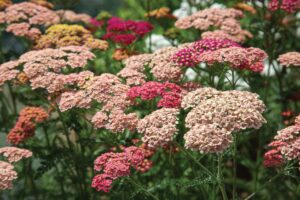Shade gardening can be challenging, but don’t let it disappoint you this summer. Few plants grow their best in low-light conditions, and the plants that do often lack gorgeous blooms. If a garden of large-leaved hostas is too monochromatic for your liking, try planting uniquely textured foliage and distinct blossoms offered by shade-loving plants. Instead of a dark, drab space, you will look forward to a shady retreat this summer, thanks to the additions in your new shade garden.
When planting your shade garden, consider the type of shade (morning vs. afternoon) and the duration of shade. Partially shaded areas get 4 to 6 hours of sunlight per day; full shade areas get less than 4 hours and sometimes no direct sunlight at all. Full shade areas are usually under dense tree canopies or covered patios on the north side of the house. To understand your shade conditions, spend time in your garden observing when the plants have direct sunlight and its duration.
Not all shade is equal; even moisture levels vary in shade. Moist shade caused by cool temperatures is ideal for some shade plants but leads to root rot in others. Moss creeping in your garden bed may indicate high moisture levels. Shade gardens under trees or shrubs may experience dry shade conditions, causing competition for water and nutrients. And all shade is a favorite spot for slugs to explore and snack.
To ensure a healthy plant, it’s important to remember to choose the right plant for the right place. A plant grown in undesirable conditions will be stressed, unhealthy and stunted. As a result, foliage color may be dull, and disease or pest problems may occur. Although beautiful blooms are a garden highlight, most plants showcase fewer flowers and briefer bloom times in the shade.
With less focus on blooms, the strength of a shade garden is foliage. Texture, color and shape all add dimension and interest. Try mixing large coarse leaves like pigsqueak and lady’s mantle with finely divided leaves of Japanese painted fern. Or, add plants with white and green variegated foliage like Solomon’s-seal or liriope.
Perennial plants provide permanence and structure in shade beds, even if bloom time is short, so focus on stunning, dependable and distinct perennials. Some to consider planting are bigleaf ligularia, large glossy leaves with 3-foot-tall daisy-like flowers; false spirea, lacy foliage with large plume-like flowers; lungwort, rough, spotted leaves with pink or purple blooms; and bugloss, green to silver heart-shaped leaves with delicate blue flowers in the spring.
Several Illinois native plants also tolerate light shade, including wild geranium, a mounding perennial with purple flowers; Northern maidenhair fern, with dark green, feathery foliage; and bugbane, white flower spikes atop black, wiry stems.
For a pop of color all summer long, add shade-loving annual bedding plants such as ageratum, wax begonia, impatiens and torenia to the garden. Then fill in with shade-tolerant groundcovers, including wild ginger, sweet woodruff and bugleweed.










